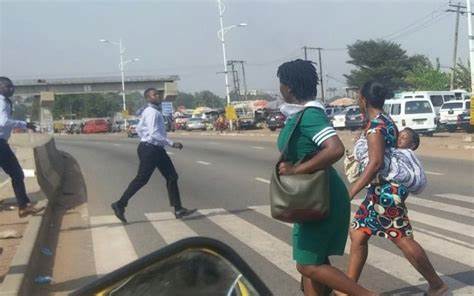Article By: Esther Agyapong
In Accra, the capital city of Ghana, over speeding remains a major cause of road crashes. Statistics from the National Road Safety Authority (NRSA) reveal that 73,830 road crashes were recorded over five years from 2019-2023. These crashes involved 127,892 vehicles made up of 54,876 private vehicles, 45,955 commercial vehicles, and 27,061 motorcycles. The National Road Safety Authority has marked over speeding as a major cause of road accidents. With many campaigns against speeding by road safety agencies and civil societies, the zebra crossing sign seems to be largely ignored.
The zebra crossing is a white-striped line marked on a road to primarily assist pedestrian movement. The advantages of zebra crossings range from pedestrian safety to promoting responsible driving behavior and efficient traffic management. They are a fundamental component of road infrastructure aimed at reducing accidents and ensuring the safety and convenience of pedestrians.
Therefore Zebra crossings symbolize more than just a safe passage for pedestrians; they represent a commitment to road safety and respect for the rights of all road users.
In Ghana, the prevalence of road traffic offences, particularly concerning zebra crossings, underscores the need for heightened awareness, enforcement, and adherence to traffic laws.
A typical stretch of a highway from Awoshie to Pokuase has about 25 traffic light stops with 10 zebra crossing stops. However, the cue for a regular commercial driver is a red or a green light
Atta Kakra is a 40-year-old driver who plies the Awoshie-Kaneshie stretch. He was taught how to drive by his retired uncle who was also a bus driver. He just remembers being taught some road signs, types of roads, and how to fix a car. He doesn’t know zebra crossing is part of road signs. He says there are overheads and bridges that pedestrians can use instead of blaming drivers on zebra crossings.
Oppong Dua is a man of speed. He is a 47-year-old commercial driver who decided to be a driver by observing as a conductor. He does not remember where a zebra crossing is marked on his stretch. He plies the route from Pokuase to Odorkor each morning and continues to Accra central. He says “I know the number of traffic stops on this stretch from my house to my last stop. I stop only when I see a red light. I must make about six trips each day to make sales for the day. If I decide to stop at the slightest crossing I would be behind time”.
Osei Darko is a pedestrian and a bank worker who must join the early morning traffic to go to work. At Madina, pedestrians would have to rely on zebra crossings largely to access bus services. He recounts several encounters of having to wait from 20 minutes to 30 minutes to cross using a zebra crossing to board a car. He believes the MTTD should enforce and put fines on drivers who do not stop at zebra crossing.
The orientation of drivers of commercial vehicles contributes to the underutilization of zebra crossings. Many drivers see the zebra crossing as unnecessary because there are bridges and walkovers instituted close to Traffic stops. The Motor Traffic Division also believes enforcement of laws and imposing fines would curb the menace. Also, a deepening of the white paintings and more vivid arrows would draw more attention. By this, over speeding would largely reduce and more caution would be exercised on the roads. Pedestrians especially school children would feel safer too to cross roads to school.
Stringent attention on zebra crossing might be the magic wand to reduce drastically the menace of road crashes.
Source: www.thenewindependentonline.com








